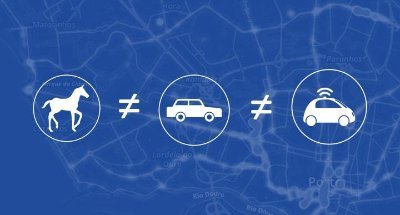The car was much more than a faster horse. Tomorrow’s autonomous vehicles will be much more than self-driving cars.
Driverless cars may still seem like science fiction—but recent investments in autonomous technologies are very real, as technology companies and car makers rush to secure their footholds in this nascent market.
Chipmaker Intel recently acquired computer-vision company Mobileye—after all, driverless cars need to “see” where they are going—in a deal valued at $15.3 billion. Nvidia announced it will be offering a self-driving computer with partner Bosch that will make it far easier for any automaker to add driverless features to cars. Then there’s Ford, which has targeted 2021 for its debut of a fully autonomous car; Tesla says they will do the same by the end of this year.
While autonomous cars are coming very fast, what is not speeding along as quickly is our understanding and appreciation of what these new vehicles can do for us, beyond chauffeuring us from home to work or a night out with friends.
What is an autonomous car, really? Sure, it’s a way to get from point A to point B without having to deal with the tedium of actual driving. But autonomous cars can be – and will be – much more than a transportation solution. If we outfit our autonomous vehicle fleet with the right technologies, these cars stand to revolutionize everything we know about wireless networking, urban data collection, and even the safety and livability of our cities.
We’ve witnessed transportation revolutions before. First when the horse was domesticated some 2,000 years ago, and again when the car arrived in the late 1800s. But even in the era of Henry Ford, the revolution wasn’t just about efficient movement. The car was much more than a faster horse. And today’s autonomous vehicles are much more than self-driving cars—they promise an array of broader benefits to our cities, and the people who live in them. Here are just a few:
Mobile Internet access. Autonomous vehicle technology will greatly improve network access to the Internet. In today’s increasingly mobile world, usage of wireless data is skyrocketing—not just by legions of mobile phone and tablet users but by vehicles themselves. Even traditional, driver-controlled vehicles are increasingly connected to the cellular network for map downloads, streaming music, and software updates on the fly, but that’s nothing compared to what autonomous vehicles will demand. Because of the vast array of sensors they rely on – GPS, lidar, radar, video cameras, and more – these cars collect, produce, and transmit a mountain of information that can currently total up to four terabytes per day.
Today’s cellular networks can’t handle even a handful of these cars, much less a fleet of thousands of them bouncing from one tower to the next. Solution: By outfitting autonomous cars with mesh networking systems, like the ones developed by Veniam, the cars become the catalyst that solves their own data connectivity problem. There’s no more overloading the network because those very cars create and scale the backbone of that network.
Technology enablers for smart cities. Autonomous cars can also be outfitted with additional sensors that allow for the emergence of truly smart cities. The city of tomorrow will adopt many of the strategies of today’s top businesses, leveraging data to constantly improve operations. What kind of data? Information about wireless network usage, latency, bandwidth utilization, and more, all data that autonomous cars connected to the mesh network can collect while they’re on the move. When city managers (or AI algorithms) spot problems and need more data or better connectivity , additional vehicles can be deployed to an area to improve service.
But cars can go far beyond simply analyzing the network. Because they’re on the road and constantly in motion, they can be used to monitor road traffic conditions and can be outfit with sensors to gauge things like air pollution and street noise. Embedded cameras can serve as a watchful crime deterrent. Cars could even report back to city hall when they encounter a pothole, water leak or a burned-out street light.
Dynamic targeting. Finally, autonomous cars could easily create new marketing opportunities by turning screens inside (or mounted on top) into precisely targeted billboards. Marketers could target a single city block with ads, or display content to passengers based on their specific destination.
Autonomous cars are coming, and it’s only a matter of time before they roll down your street. Let’s take advantage of the infrastructure we’re already building to fully utilize everything they have to offer.
https://www.linkedin.com/pulse/why-autonomous-cars-much-more-than-driverless-vehicles-joão-barros

Hi! I am a robot. I just upvoted you! I found similar content that readers might be interested in:
https://www.veniamworks.com/why-autonomous-cars-will-be-much-more-than-driverless-vehicles/
nice post :)